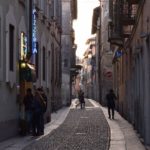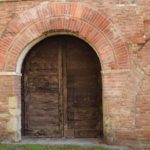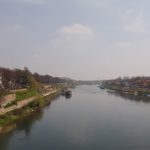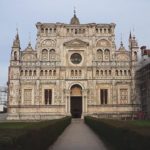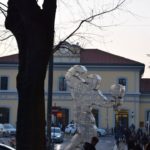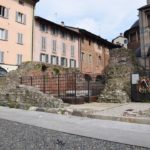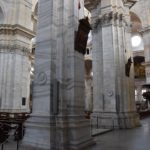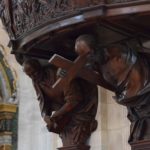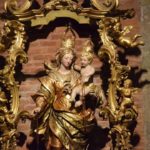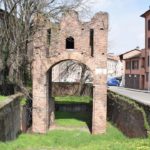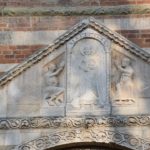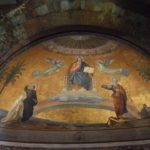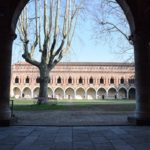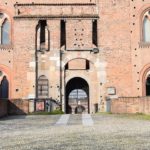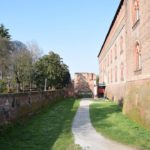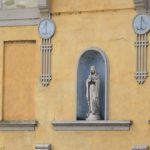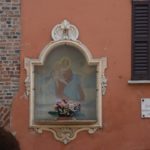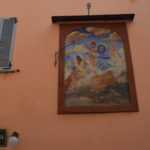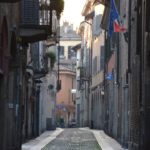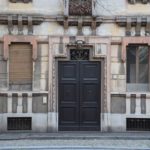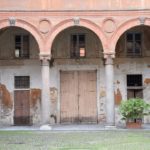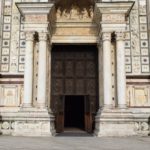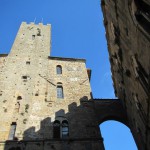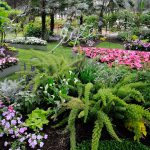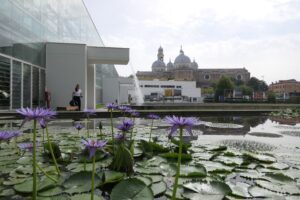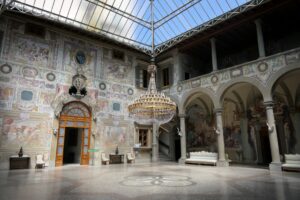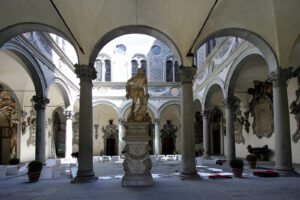Lombardy’s most beautiful Renaissance monastery
Pavia, a charming city
Dressed in art and architecture, and bubbling with the energy of youth!
by Virginia Merlini
Living in metro Milan for half a year, I used the convenient buses and trains of the Italian public transportation system to visit the beautiful cities located close by. And so, on a sunny morning my adventures led me just twenty-eight miles south to spend the day trekking Pavia.
Pavia, through which flows the Ticino River, has a fascinating and lengthy history. The city – established in an unnamed epoch by a ferocious people who sold their fighting skills to others – was a military camp in 3rd-century BCE that protected the first Roman bridge built over the Ticino – claims the 5th-century reign of the last Roman emperor to subordinate Italy – was the capital of the Kingdom of the Lombards in the 6th century – contains the bones of the Doctor of the Catholic Church St. Augustine of Hippo in the early 12th-century church of San Pietro in Ciel d’Oro (St Peter in the Golden Sky) – is home to a university founded in the 14th-century – boasts the 15th-century Ospedale di San Matteo, a medieval clinic for all ill needing care that is now one of the most important hospitals in Italy – and is just a charming, lovely, art and ancient architecture filled, vibrant city in which to spend a day!
- Pavia, pretty cobblestone street
- Pavia, beautiful old door!
- The Ticino River as seen from the Coperto
Modern Pavia is a small and beautiful river town once known as Ticinum to the Romans who absorbed it into their empire sometime around the 2nd century BCE. My goal was a brief but leisurely ingestion of the ancient river city and a visit to the ten ‘top’ sights listed on the printable map that I found online. But my day was such a smashing success and I loved the city so much that I did not leave until night fell and I was in danger of missing the last train back to Milan.
With its location on a major river the surrounding plains of which host most of the area’s arable land, Pavia has a well established identity predating its Roman occupation. However, as is the case for many cities with prehistoric pedigrees, its pre-Roman roots are not fully agreed upon and are still disputed. Pliny the Elder (23-79 CE) – a philosopher and commander in the early Roman military – said it was founded by Ligurian tribes – notably the red-haired Ligures – who had Celtic roots and occupied the area near modern Genova – a road to which the current bridge over the river leads! Ptolemy (100-c.170 CE) – the Greco-Roman polymath – claims that the Insurbes – a tall Gaulish people with roots in Lombardy – controlled the area. Although the truth of Pavia’s first settlement may be lost to us, the city remains a wonder worthy of a long visit!
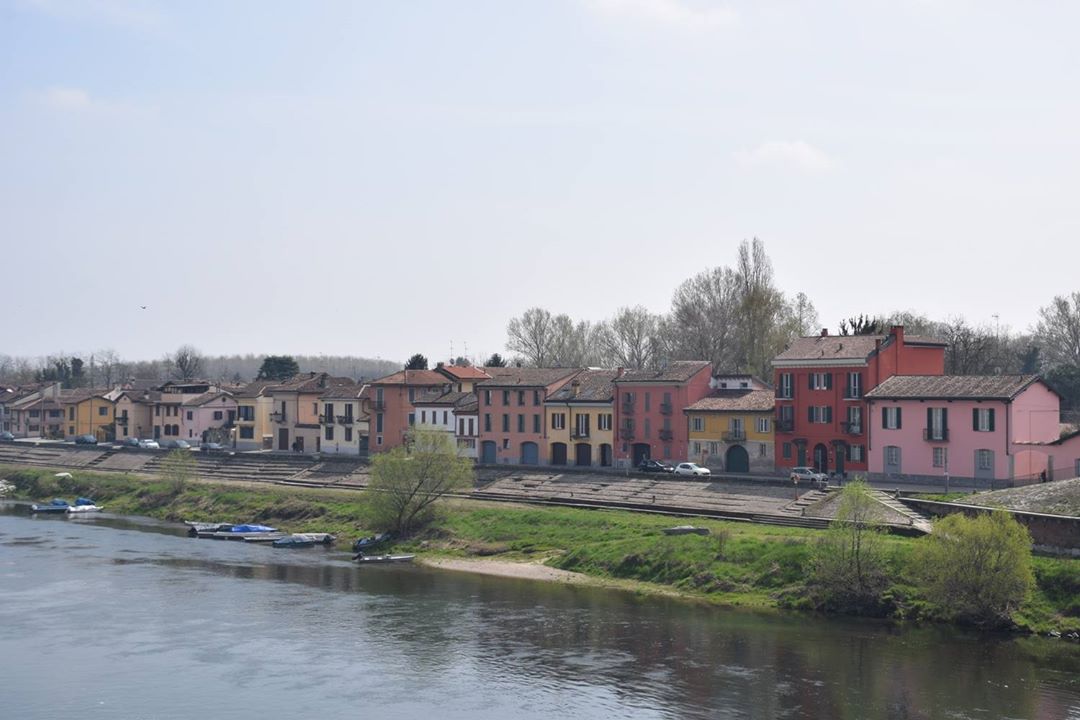
Pavia, Ticino River – old homes of the ancient fishing quarter on the riverbank
Pavia is surrounded by the remnants from its long life and the views from a train window delight! The brief journey due south of Milan to Pavia – the terminus of Milan’s 16th-century Naviglio Pavese – takes one through rich farmland and the 80,000 acres of rice paddies of the Pianura Padana – the flat plain that makes up the fertile Po River valley. The Po is the major river of Lombardy and the Ticino is its left-bank tributary. Because water is the essential material needed for life of all forms, Italians situate themselves in terms of their proximity to the waters that sustain them. Hence, the locals call my train window view the Oltrepò pavese – the other Po (River) shore. And thus – as my favorite Milan guide Lara Ioan tells me – in Pavia Oltrepò pavese, in Parma Oltrepò parmense, in Ferrara Oltrepò ferrarese, in Mantova Oltrepò Mantovano, and in beautiful Florence through which the Arno River flows – Oltrarno! These wonderful sobriquets illuminate the Italian sentiment in ways my “tourist” nickname for this area – the ‘rice capital’ of Italy – cannot!
About halfway to Pavia one will find the astonishing 14th-century walled monastery founded by the Carthusian monks: the Certosa di Pavia. Though no longer navigable, the Naviglio Pavese flows by the Certosa and is still used to irrigate the rice paddies that produce the short-grained, exclusively Italian, Arborio rice. The religious complex is worth a visit if just to see the sparkling white marble façade of the church that was modeled after Milan’s Duomo. But be warned – no photos are allowed inside and the large, art-filled interior is dimly lit making much of its beauty inaccessible.
- Certosa di Pavia – the white marble facade
- Pavia, railway station
- Pavia, Piazza del Duomo – the remains of the ancient twin churches
Once arrived and map in hand, I began my visit to the ten recommended sights of Pavia at the brightly colored train station. The 19th-century Stazione di Pavia is conveniently located an easy and well marked fifteen-minute walk down the Corso Camillo Benso Cavour to the centro storico where one finds the large and impressive 15th-century Duomo, the Cattedrale di Pavia. My first visit was to the Piazza del Duomo. The piazza is large and popular – a lively place where students gather to eat their lunch on the steps of the cathedral. The square is dominated by the Duomo di Pavia, the seat of the diocese that was built on the site of ancient twin churches – Santo Stefano and Santa Maria del Popolo. The ancient remains of these churches are preserved in a small fenced off area and fountain that contains pieces of columns.
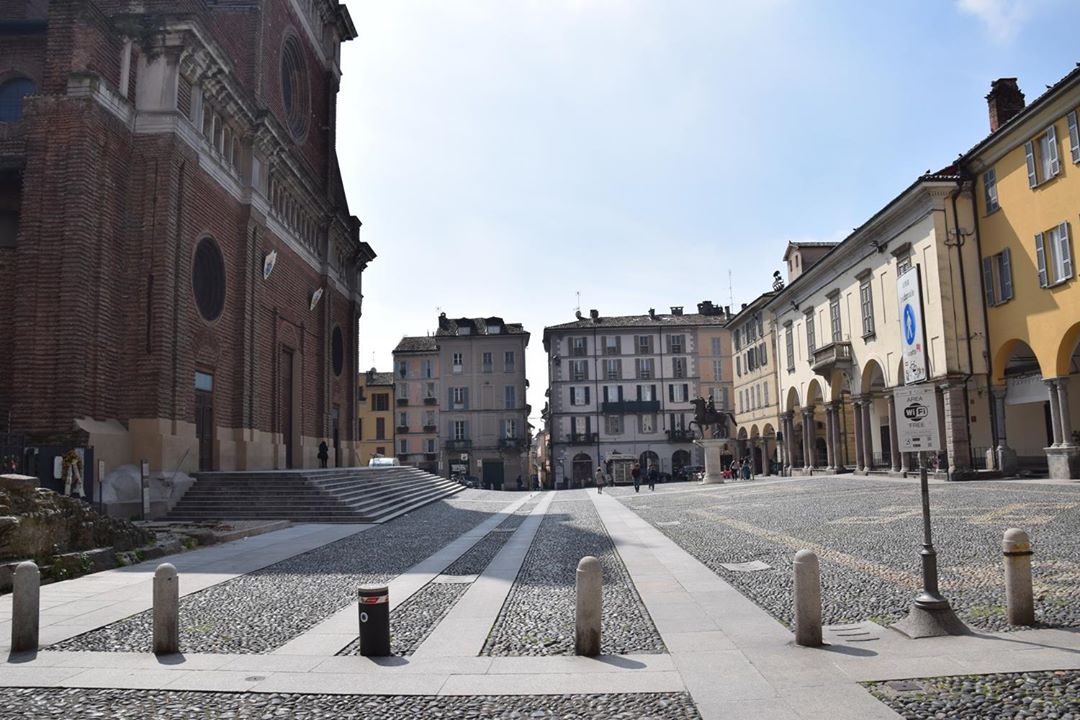
Pavia, Piazza del Duomo
The Duomo is constructed of brick, as is typical of the Lombard Romanesque and Renaissance architecture, and is very large – the largest church in the city actually. The church is dedicated to two saints and is formally known as the Cattedrale di Santo Stefano Martire e Santa Maria Assunta (Cathedral of Saint Stephen the Martyr and the Assumption of Saint Mary). The intended marble cladding of the face of the cathedral remains unfinished. Delays in construction of the church included a lack of funds, disagreements about what should be the design, and diversions to the completion and marble decorations of the interior that took precedence. Unlike the other Pavia churches I visited that day, this church was white marble inside – columns, altars, and embellishments. Of all the artifacts, I liked a wooden statue of the Virgin best.
The Churches in the city centre
My next stop was the Basilica di San Michele. This church dates from the early 12th-century. The current church was built on the site of an ancient Longobard church. The Longobards or Lombards – after whom the region is named – dominated Italy for two centuries – 568 to 774 CE. We have them to thank for the many Madonna’s in ancient art with auburn hair. The Basilica di San Michele was used as a palatine chapel and as such hosted the coronations of all the sovereigns of the Italic Kingdom. To reflect its stature, a decision was made to completely decorate the facade with stone. This was exceptional since only brick was used for churches at this time. Although the soft stone used has eroded, the grandeur of the decorations is still evident especially in the repeated designs found outside and inside on the capitals. I offer some montages to show the wonderful exterior carvings. Unfortunately, I got to the church about 3 minutes before it closed so my photos do not reflect its architectural and decorative grandeur. Because of my late entry, I did not get many careful photos of the interior. The well restored interior was a mix of artwork from the different ages.
- Duomo di Pavia, the interior of the chuch is all white marble
- Duomo di Pavia pulpit – carved wooden images of saints
- Basilica di San Michele – an ornate Baroque Virgin and Child
The Basilica di San Teodoro is another 12th-century chiesa. This church is located on the side of the Ticino in what was the medieval fishing center of ancient Pavia. The Basilica di San Teodoro is kept open by Touring Club Italiano. Hence, there are generous visiting hours. These are mosaics from the original ancient 8th-century church floor. I found the hoofed feet of the mythological beings very interesting. These are not Christian holy figures and are likely deities or heroes, and creatures from the local religion that predated this Christian church. The mosaics were discovered when a new heating system was being installed in the basilica in 1998. The ancient floor was hidden by repairs made to the church centuries prior when the building had settled. My friend David Vine has found and translated two Italian sources which speak to the allegorical content of the mosaics. The figures in the mosaic are accompanied by inscriptions with the names Satrio and Anselmus – and one of the sources speculates that these are satyrs hunting.
The church has paintings that tell the story of the lives of the two saints central to this basilica – Teodoro, Bishop of Pavia (died 778 CE) and the martyred Agnes (291-304 CE). The current basilica was built over an earlier church dedicated to Saint Agnes. Since few were literate in antiquity, art was used to convey the important history and mythologies of the faith. Often the intentionality of church art is hidden to the average tourist. But the language of color and form still speak to our senses and unite us to other cultures in our similar humanity. I see churches as art museums and in Lombardy all these ‘museums’ have no entry fees, making beauty and history and the heart of the people accessible to all.
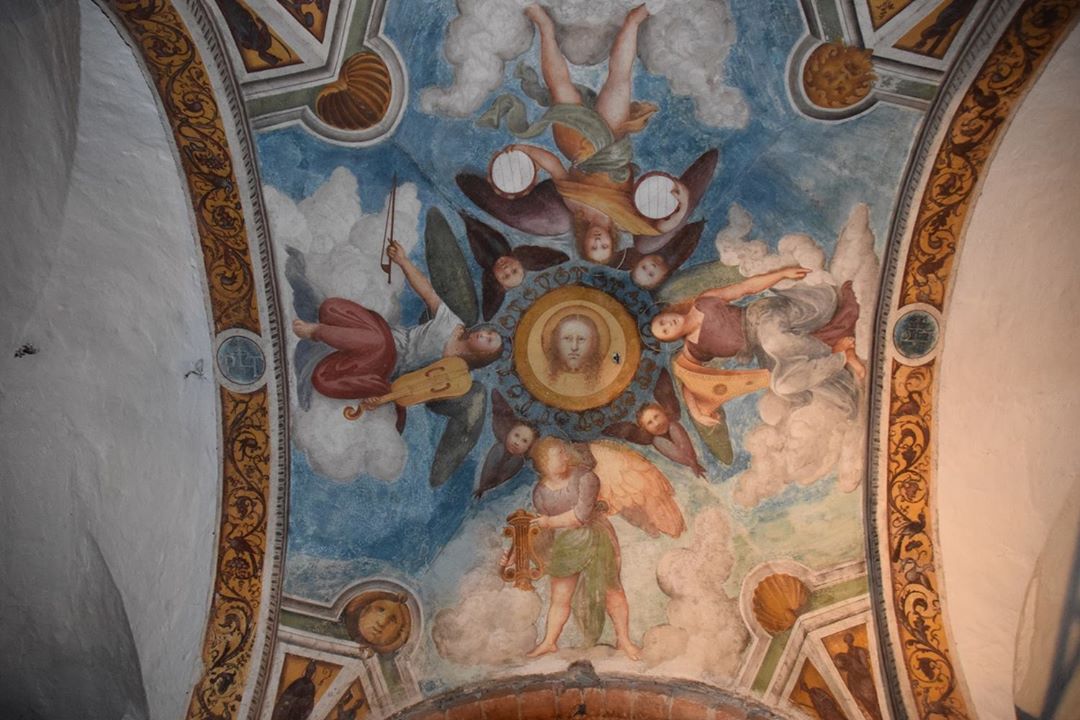
Basilica di San Teodoro – colorful ceiling
A brief walk down the narrow alley – Via Porta Calcinara – to the river from San Teodoro brings one to the ruins of an ancient city gate of the same name and similar age to the basilica – Porta Calcinara. Pavia like many medieval centers was once walled, the main gates corresponding to the important roads to trade cities such as Milan and and Cremona. Porta Calcinara sat close to the Coperto, the bridge that led to the road to Genova and offered traders access to the town and local fisherman access to the river. The Basilica di San Pietro Cielo d’Oro is an early 8th-century church. It was built specifically to house the remains of St Augustine of Hippo (354-430 CE). The large marble tomb in the upper right photo in the montage below is the Arca di Sant’Agostino carved in 1362. It contains the 8th-century box with the relics of the author of the Confessions – a long autobiographical work that speaks of the saint’s ‘sinful youth’ (He once robbed an orchard and did not even eat the fruit he stole!) and his conversion to Christianity. It is still in publication after over 1,500 years!
- Pavia, Porta Calcinara
- Basilica di San Pietro Cielo d’Oro – above the front entry door
- Basilica di San Pietro Cielo d’Oro – above the front altar – ceiling mosaic
The church is so famous that Dante mentions it in his Divine Comedy when he speaks of the burial of the Roman Christian philosopher Severino Boezio. And Boccaccio speaks of the church in his novella collection “The Decameron” (love tales ‘narrated’ by ten youths, seven women and three men, hiding in a villa near Florence to escape the Plague). I got to the basilica after 6pm. There were people singing what I thought was a chanting of the rosary. Since it was not a formal Mass, I proceeded to take photos even going so far as to lie on the floor behind the altar to get a full photo of the mosaic ceiling. When I put on my glasses and turned around I saw that the lay people who I thought were singing the rosary were actually monks chanting their vespers. I was mortified by my rudeness! This church, also, is kept open by the fabulous Touring Club Italiano.
The Palazzo Broletto is a 12th-century building in the very large, very beautiful, and consequently very busy Piazza della Vittoria. The Broletto was built over Roman ruins and originally housed the local bishop. Now it is used as a place for temporary art exhibits. It is lovely to sit here and have a beverage!
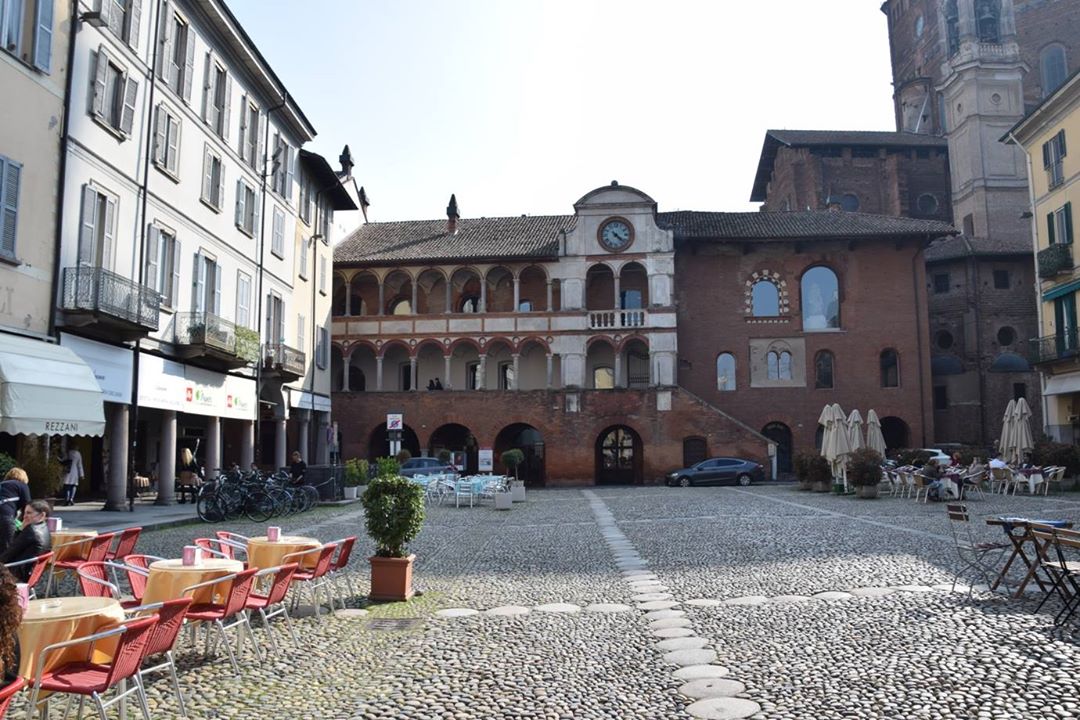
Pavia, the Broletto
The main bridge over the Ticino which leads to the historic center of the city is the Ponte Coperto. This fabulous covered bridge with a church in the middle of it has Roman origins. Some of the original Roman elements are still part of the current 14th-century bridge. It is very beautiful and – as in ancient times – the road to which it connects Pavia still leads to Genova.
The present bridge was built between 1352 and 1354 by the architects Giovanni da Ferrera and Jacopo da Cozzo on top of the ruins of the old Roman bridge that spanned the river in the 3rd century BCE when Pavia was still called Ticinum. In the middle of the bridge is a chapel dedicated to Saint John of Nepomuk (1345-1393). St John – who hailed from Bohemia (the current Czech Republic) – was drowned in the Vitava River on orders of the king. John was the confessor of the queen and the king wanted to know what his wife had ‘confessed’. When St John refused to violate the sanctity of the confessional the king had him drowned. St John is now a protector saint from floods and drowning. He is a fitting patron to guard travelers on this bridge!
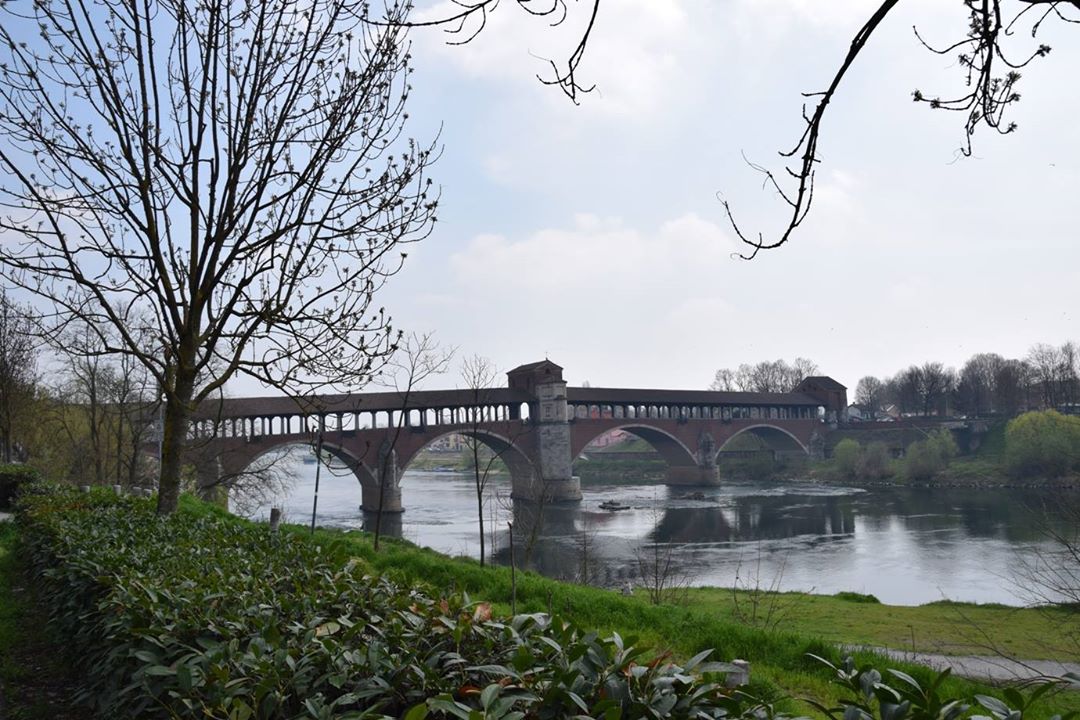
Pavia, Ponte Coperto
The Chiesa di Santa Maria del Carmine is impressive! This huge 14th-century church was once completely dressed in frescoes that covered the walls and all the very large columns. The remaining frescoes have been restored and the work speaks to their original beauty. Updated art was created in the chapels in the 16th and 19th century. But I love the older – though imperfect – frescoes. I have created montages so that I can share more photos. This fabulous and newer baptistry had an egg hanging over the font. This recalls the painting in the Pinacoteca di Brera by Piero della Francesca that was commissioned by Federico da Montefeltro which shows an egg hanging over the Virgin’s head. In the pagan religion which was ultimately absorbed by and amalgamated with the newer cult of Christianity, the egg was emblematic of new life. In Catholicism, the egg symbolizes the new life of Christ when he awakes from death. The unbroken shell represents the tomb of Jesus and when cracked open the prophet has a new life – he is resurrected. Since the baptism is believed to offer the individual a new life in Christ, it is a fitting symbol to display over a baptismal font.
The Castle and Museum
The Castello Visconteo was closed when I arrived. I did not have the pleasure of exploring the building and its courtyards. This expansive and imposing castle which now serves as the Civic and Art Museum was built by Galeazzo II Visconti (1320-1378) who ruled Milan from 1349 until his death. Galeazzo wanted a splendiferous fortress located inside a large hunting park. The original grounds extended out ten kilometers from the castle. A small part of the park still serves the city but it is no longer attached to the castle grounds. The old moat around the castle is now a walking path!
- Pavia, Castello Visconteo – an interior courtyard
- Castello di Visconteo – one of the entry gates to the castle.
- Castello Visconteo – the old moat the surrounds the castle is now a walking path!
The Chiesa di Maria Incoronata di Canepanova was the last church that I visited. This is a small, nondescript Renaissance church founded in 1492 to house and protect a painting of the Virgin to which miracles were attributed. The church facade and location are humble and devoid of the ostentation of the more glamorous and larger churches in the city. Perhaps the motivation for the simple exterior is the quiet gratefulness for the miracles alleged of the Virgin. The current church was built between 1500 and 1507. The famous architect Giovanni Antonio Amadeo (1447-1522) designed the building and although not lovely with old frescoes it houses the purported miraculous icon of the great Virgin at its altar, before which prayer and entreaty have reportedly resulted in miracles. Curious as I was, I could not find information on the ancient miracles that led to the icon’s veneration! Perhaps next time! One can see more of the work of Giovanni Antonio Amadeo in the Certosa di Pavia, for which he carved the bas-reliefs on the right front facade of the church.
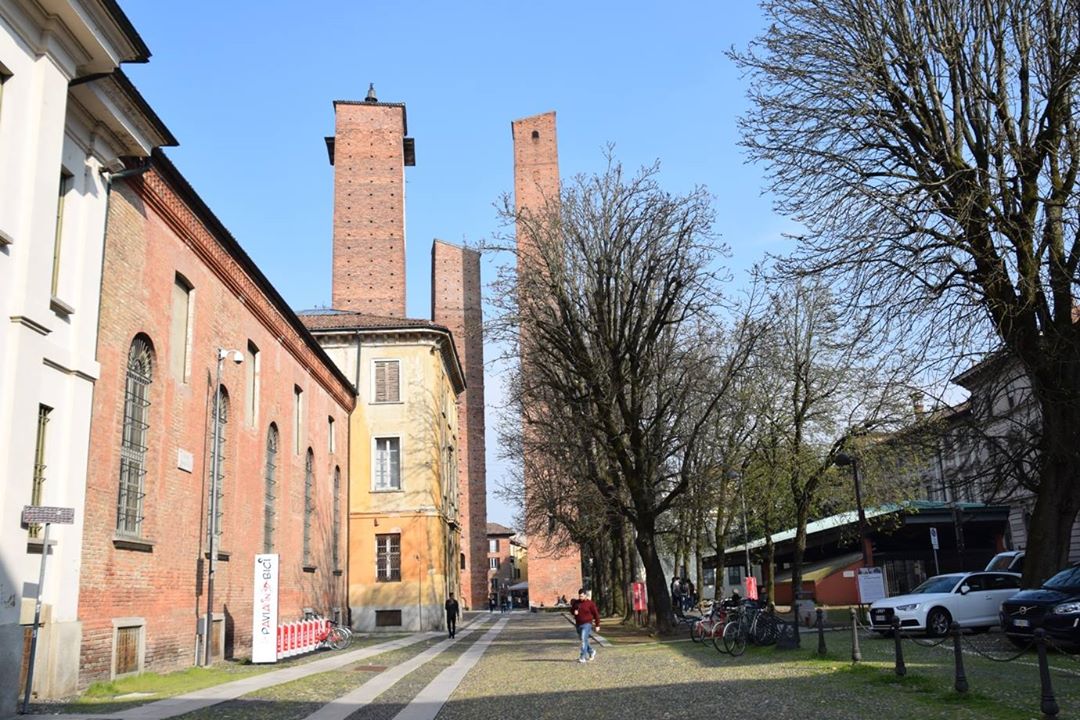
Torri Gentilizie, my best photo of all three towers!
I really liked walking the piazza filled with students where one finds the Torri Gentilizie (Noble Towers). These three 12th-century medieval towers sit next to the ruins of the 7th-century church and crypt of San Eusebio, and are situated in the middle of the University of Pavia. Pavia was once known as a city of towers. There are the remains of sixty towers to be found in the present city but only six remain completely intact. It is difficult to get a good photo with all three towers. I tried!The expansive and renowned Università degli Studi di Pavia was founded in 1361. There is evidence, however, of an institute of higher learning in Pavia some 500 hundred years prior, in the 9th-century. The current school has over 21,000 students and eighteen departments. The buildings of the university are found throughout the city.
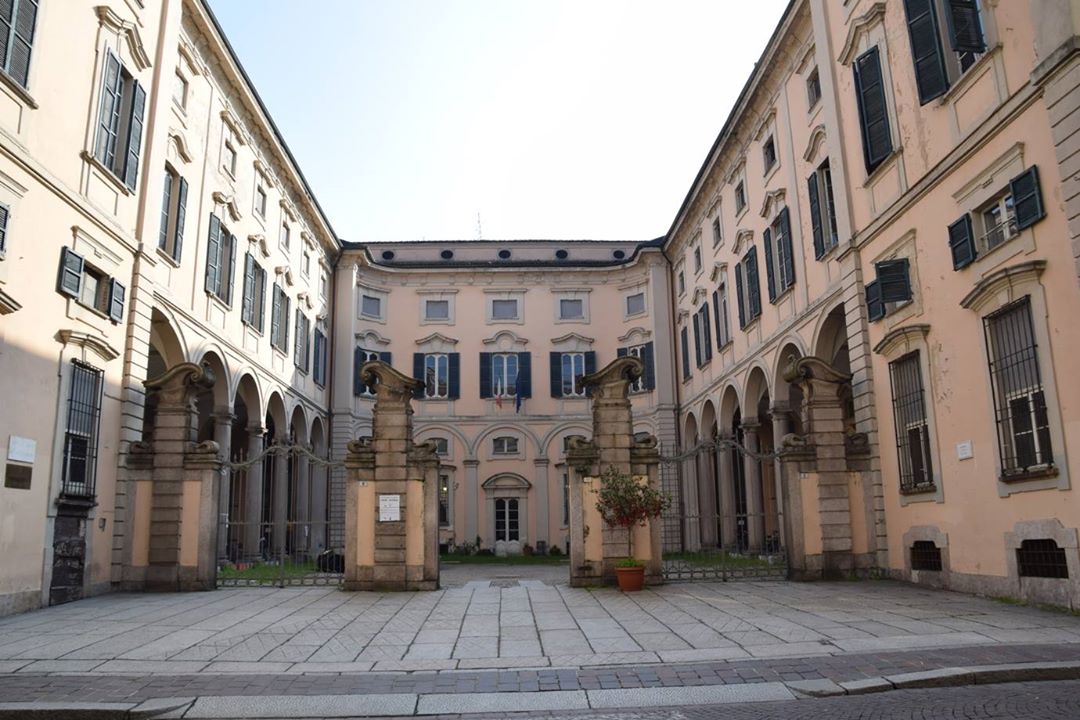
Pavia, Università degli Studi di Pavia – courtyard of some of the university buildings.
Lunch! I walked by a small kebap restaurant that smelled so good I had to have one. I had not had a kebap since my last time in Brussels nearly forty years ago. It was my standard dinner as a flight attendant because we had to stretch our small per diem that was not enough to cover normal meals. The Doner Kebap is made of seasoned meat stacked in a cone shape vertically onto a skewer and then roasted over a fire. It is an invention of the Ottoman Empire. Traditionally the meat cooked was lamb or mutton only. Nowadays, the meat is often a mixture of lamb or mutton, beef, chicken, and/or turkey.
Looking for street art
In pursuing one of my favorite photo-ethnographic themes, I only found a few Wall Madonna’s. I need more time to explore the old city to find more!
This is a great Deposition of Christ sculpted on a university building that is part of the still famous 15th-century Ospedale di San Matteo which was founded to treat all those who were ill regardless of their class or circumstance. The frieze is located in the Piazza Leonardo Da Vinci, where one, also, finds the Torri Genilitizie and the crypt of the ancient, demolished church of San Eusebio. The crypt was closed when I got there. This beautiful wall sculpture is found in the area named Largo Giorgio La Pira – named for the famous Roman Catholic politician from Florence who died in 1977. My good friend David Vine translated the Latin inscription on the wall sculpture for me – The present royal court, a city once pious and renowned for its citizenry, establishes, as an act of piety, this hospice for the poor. Herein through caring physicians the sick are restored to health and the indigent live sheltered. Herein there thrives a single faith.
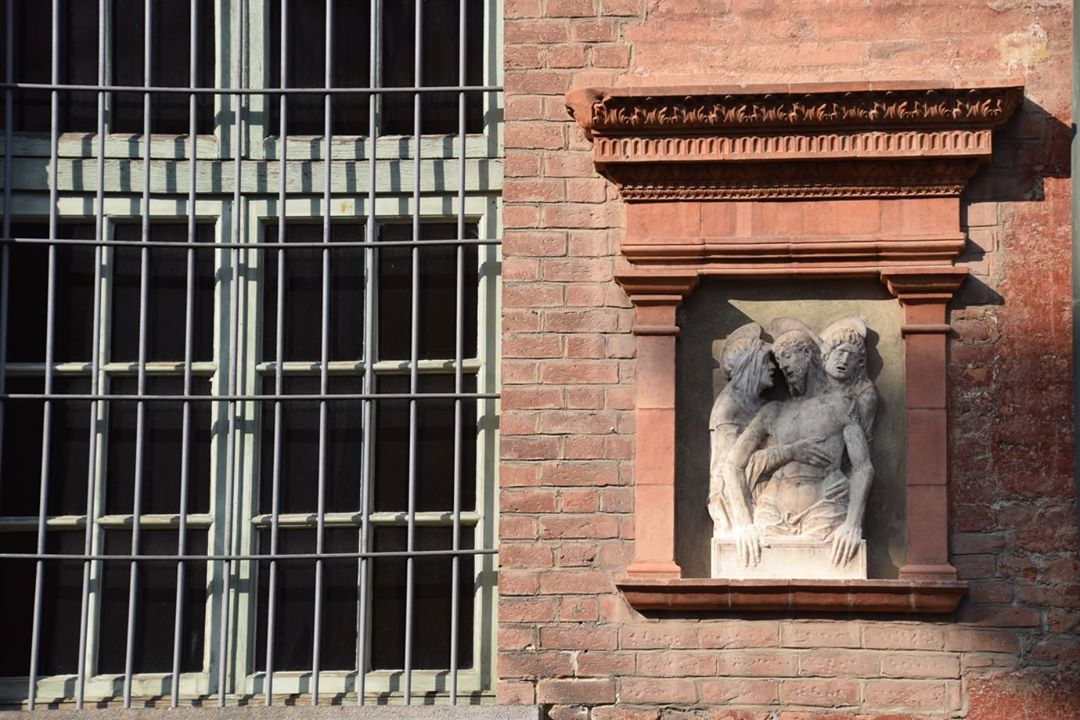
Deposition of Christ – Latin inscription translated by David Vine – “The present royal court, a city once pious and renowned for its citizenry, establishes, as an act of piety, this hospice for the poor. Herein through caring physicians the sick are restored to health and the indigent live sheltered. Herein there thrives a single faith.”
Here are the Wall Madonna’s that I discovered!
- Pavia, Wall Madonna
- Pavia, Wall Madonna
- Pavia, Wall Madonna
Pretty streets! Pavia’s streets are paved in cobblestones, narrow, and very picturesque. The main vie and corsi (avenues and boulevards) are beautiful and lined with shops, cafes, bars, and thronging with people. But the side streets beg to be explored for their tiny pizzerias, local groceries, bars, and crafts studios.And off course, Pavia has fabulous doors! I finish this narrative with photos from my other favorite theme: doors!
- Pavia, pretty street!
- Pavia, pretty door!
- Pavia, door inside the courtyard of the 15th century Palazzo Orlandi
This was the door to the Ristorante Bardelli on the bank of the Ticino. The owner saw me taking pictures and came out to show me around. She was very proud of her restaurant and its beautiful doors:
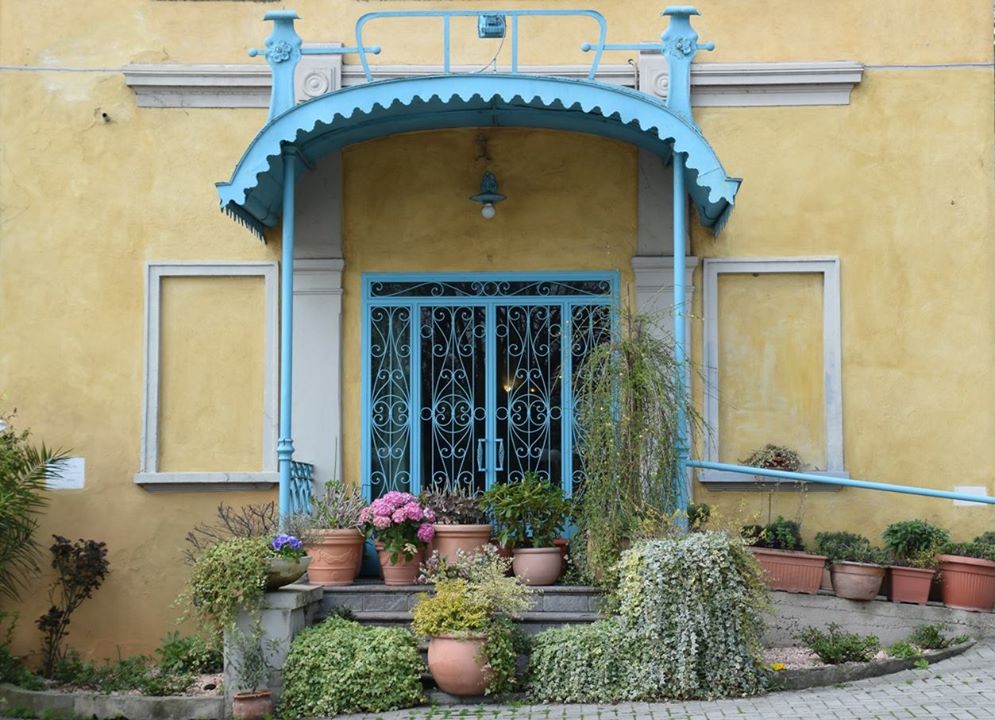
Pavia, door to the Bardelli Ristorante
I hope that this narrative and these photos which trace my walk around the historic center of the city succeed in translating my delight in Pavia and spur you to your own visit! Ciao!
Virginia Louise Merlini
More pics on her Facebook Profile

